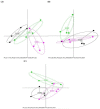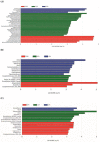Low Concentration of Antibiotics Modulates Gut Microbiota at Different Levels in Pre-Weaning Dairy Calves
- PMID: 30486334
- PMCID: PMC6313529
- DOI: 10.3390/microorganisms6040118
Low Concentration of Antibiotics Modulates Gut Microbiota at Different Levels in Pre-Weaning Dairy Calves
Abstract
The aim of this study was to investigate the effect of feeding milk replacer (MR) with two different antibiotics treatments on the gut microbiota of pre-weaning calves. Twelve (12) Holstein male calves at 1-day-old were randomly assigned to: milk replacer without antibiotics (CON), milk replacer plus low cocktail of antibiotics (LCA) concentration (penicillin 0.024 mg/L, streptomycin 0.025 mg/L, tetracycline 0.1 mg/L, ceftiofur 0.33 mg/L), and milk replacer plus a low concentration of single antibiotic (LSA; ceftiofur 0.33 mg/L). All the calves were harvested at 35-day-old, and the digesta from the ileum and colon was collected in addition to fecal samples. Samples were analyzed by 16S rRNA gene using Illumina MiSeq platform. Results showed that there were significant differences among treatments in the ileum, where LCA significantly reduced the relative abundance of Enterobacteriaceae (P = 0.02) especially Escherichia-coli (P = 0.02), while LSA significantly reduced the relative abundance of Comamonas (P = 0.02). In the colon and rectum, LSA treatment was significantly enriched with the class Bacilli, whereas the control group was significantly enriched with Alloprevotlla (P = 0.03). However, at the family level in the rectum LCA and LSA significantly reduced the relative abundance of Acidaminococcaceae (P = 0.01). Moreover, at the genera level in the colon, LSA significantly increased Prevotellaceae_Ga6A1_ group (P = 0.02), whereas in the rectum both of treatments reduced the relative abundance of Phascolarctobacterium (P = 0.01). In conclusion, the overall low cocktail of antibiotics concentration induced changes at different taxonomic levels; specifically the decrease in Escherichia-coli which might subsequently reduce the incidences of diarrhea in calves.
Keywords: antibiotics; calf; colon; ileum; microbiota; rectum.
Conflict of interest statement
The authors declare that they have no competing interests.
Figures





Similar articles
-
Effects of antibiotic residues in milk on growth, ruminal fermentation, and microbial community of preweaning dairy calves.J Dairy Sci. 2019 Mar;102(3):2298-2307. doi: 10.3168/jds.2018-15506. Epub 2019 Jan 26. J Dairy Sci. 2019. PMID: 30692007
-
Feeding Pasteurized Waste Milk to Preweaned Dairy Calves Changes Fecal and Upper Respiratory Tract Microbiota.Front Vet Sci. 2019 Jun 6;6:159. doi: 10.3389/fvets.2019.00159. eCollection 2019. Front Vet Sci. 2019. PMID: 31245388 Free PMC article.
-
Effects of milk, milk replacer, and milk replacer plus ethoxyquin on the growth performance, weaning stress, and the fecal microbiota of Holstein dairy calves.Front Microbiol. 2023 Mar 13;14:1113518. doi: 10.3389/fmicb.2023.1113518. eCollection 2023. Front Microbiol. 2023. PMID: 36992934 Free PMC article.
-
Excretion of antibiotic resistance genes by dairy calves fed milk replacers with varying doses of antibiotics.Front Microbiol. 2012 Apr 10;3:139. doi: 10.3389/fmicb.2012.00139. eCollection 2012. Front Microbiol. 2012. PMID: 22514550 Free PMC article.
-
Ingestion of Milk Containing Very Low Concentration of Antimicrobials: Longitudinal Effect on Fecal Microbiota Composition in Preweaned Calves.PLoS One. 2016 Jan 25;11(1):e0147525. doi: 10.1371/journal.pone.0147525. eCollection 2016. PLoS One. 2016. PMID: 26808865 Free PMC article.
Cited by
-
Metagenomic analysis provides bases on individualized shift of colon microbiome affected by delaying colostrum feeding in neonatal calves.Front Microbiol. 2022 Nov 1;13:1035331. doi: 10.3389/fmicb.2022.1035331. eCollection 2022. Front Microbiol. 2022. PMID: 36386713 Free PMC article.
-
Feeding Pre-weaned Calves With Waste Milk Containing Antibiotic Residues Is Related to a Higher Incidence of Diarrhea and Alterations in the Fecal Microbiota.Front Vet Sci. 2021 Jul 8;8:650150. doi: 10.3389/fvets.2021.650150. eCollection 2021. Front Vet Sci. 2021. PMID: 34307516 Free PMC article.
-
Age-Related Changes in the Ruminal Microbiota and Their Relationship With Rumen Fermentation in Lambs.Front Microbiol. 2021 Sep 20;12:679135. doi: 10.3389/fmicb.2021.679135. eCollection 2021. Front Microbiol. 2021. PMID: 34616372 Free PMC article.
-
Metagenomic and metabolomic analyses reveal differences in rumen microbiota between grass- and grain-fed Sanhe heifers.Front Microbiol. 2024 May 13;15:1336278. doi: 10.3389/fmicb.2024.1336278. eCollection 2024. Front Microbiol. 2024. PMID: 38803375 Free PMC article.
-
An Overview of Waste Milk Feeding Effect on Growth Performance, Metabolism, Antioxidant Status and Immunity of Dairy Calves.Front Vet Sci. 2022 May 17;9:898295. doi: 10.3389/fvets.2022.898295. eCollection 2022. Front Vet Sci. 2022. PMID: 35656173 Free PMC article. Review.
References
-
- Yeoman C.J., Ishaq S.L., Bichi E., Olivo S.K., Lowe J., Aldridge B.M. Biogeographical Differences in the Influence of Maternal Microbial Sources on the Early Successional Development of the Bovine Neonatal Gastrointestinal tract. Sci. Rep. 2018;8:3197. doi: 10.1038/s41598-018-21440-8. - DOI - PMC - PubMed
LinkOut - more resources
Full Text Sources
Research Materials

